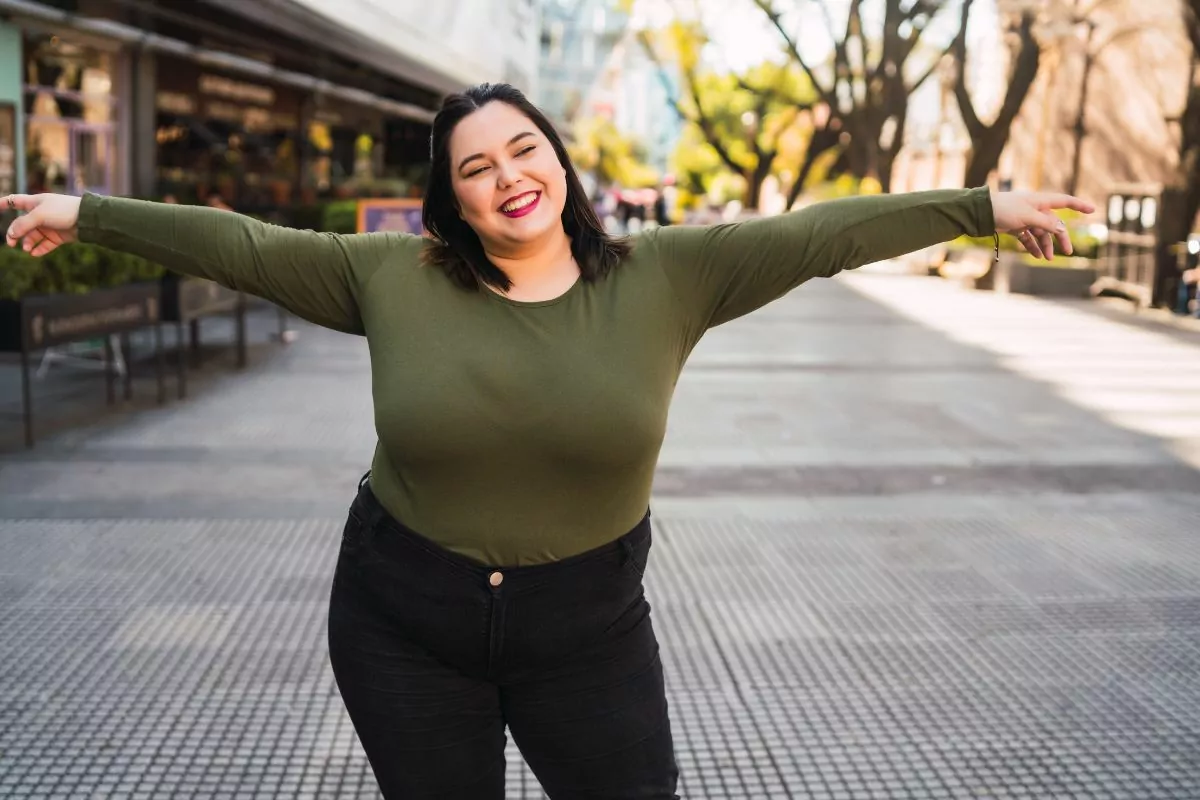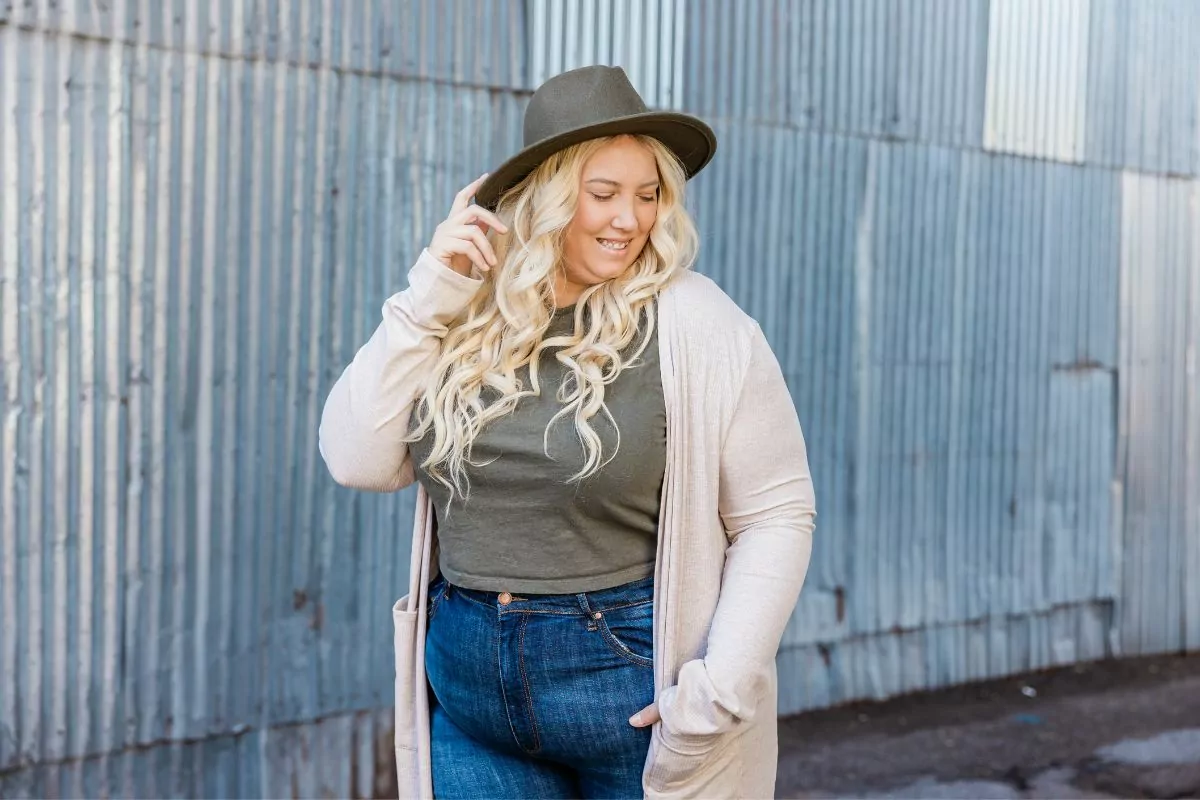When you have a fuller figure, clothes shopping can be a confusing experience. In one store, you fit in straight sizes. The next, you’re plus size. And some don’t have clothes for you at all (boo!).

Not to mention that very few bodies are the same size from top to bottom.
It’s not unusual to fit straight sizes on one half and plus sizes on the other, or find clothes are simultaneously too loose and too tight. That’s why it’s often beneficial to understand measurements, rather than sizes.
A plus-sized waist is generally considered to measure 35” and above.
In this guide, we’ll explain what that means for clothing sizes, the difference between straight and plus sizes, and finding clothes that work for you and your body.
What Is Considered A Plus Size Waist?
Plus-sized clothing can be a little confusing, especially when we take into account all the different potential measurements.
Plus-sized clothing is often considered to start at size 18, which is the equivalent of XXL, 14W, and 1X. That’s quite a few different labels to keep track of!
In terms of measurements, a plus-sized waist is typically considered 35” and above. Clothes designed to fit size 18 will measure roughly 35” at the waist.
Sizes 14/16 are generally where straight sizes stop, although some do go up to size 22. So, 18 won’t automatically equate to plus size!
While 35” is a fairly standard measurement for plus size, it isn’t a set rule. If you’ve ever bought clothing, then you probably know that sizes differ from brand to brand.
What one store considers plus-sized might be straight in another (and vice versa).
In addition, you need to consider the style of clothing. A form-fitting dress is going to need every inch of that waist allowance. Meanwhile, a loose sweater has more room to play with sizing.
It’s all pretty confusing, and the sizing variation can make clothes shopping a hassle for any body type. But knowing your measurements can help you find the clothes that are right for you.
How Do You Measure Your Waist?
If you want to understand your correct clothing sizes, you need to know your measurements. This means you need to know how to measure yourself properly.
Remember, the actual number on the tape measure doesn’t reflect your self-worth — any number is good! But it does reflect the size of clothing you should be buying.
Begin by taking your clothes off. You want an accurate measurement and even a light t-shirt will get in the way.
Next, you need to find your waist. Feel for the bottom of your ribs and the top of your hips. Your waist is part way between the two, sitting just above your belly button (Also check out Should You Wear Your Pants Over Or Under Your Belly?).
Place a tape measure around your middle at this part way point. It should be pulled tight to the skin without digging in. Essentially, where you want your clothes to fit!
Breathe in and out naturally. You don’t want to suck your stomach in or puff it out. Check the measurement and make a note of it.
Now, repeat! Take the tape measure away, feel for your waist, and reapply the tape measure.
This might seem a little bit pointless, but it’s a good way to make sure you’ve got everything right.
Make a note of your measurements in both inches and centimeters. This is helpful if you want to buy clothes online, which might come from other countries.
Considering Waist Size When Buying Clothes

Our bodies come in all kinds of shapes and sizes, and that includes the waist.
For some women, the waist is the smallest point of the torso, measuring less than the hips and shoulders.
For others, the waist is smaller than the hips but bigger than the shoulders. Or you might be fairly straight all along the torso!
If you’re buying a form-fitting dress, then it’s important to consider the waist size. These styles are designed to hug the body. Too tight or too loose at the waist can throw off the entire line of the outfit.
Waist size is also worth noting if you’re buying pants or skirts that sit on the waist (or high on the hips). These clothes are designed specifically for a closer fit at the waistline.
But for looser-fit garments, the waistline isn’t always the most important consideration. These tend to skim over the waist on the way to the hips, avoiding a tight finish.
Waist Size And Body Shape
Clothing sizes can never fully encompass every body shape. One person who fits in a size 18 might look completely different from another person who wears the exact same size.
The waist measurement is only one small aspect of your overall body.
If you have an hourglass body shape, you might find that while your waist isn’t plus-sized, your hips and bust are (Also check out What Is A Figure 8 Body Shape?). When buying dresses and pants, a belt can help clothes fit snugly at the waist while skimming the hips.
If you’re pear-shaped, with a wider waist and hips to a smaller bust and shoulders, plus-sized dresses might be loose at the top. A few darts at the bust can potentially improve the overall fit.
If you have a straight body type, close-fit clothing might pull across the waist but fit well around the hips. Consider A-line styles or shift clothing instead.
What Is The Difference Between Plus Size And Straight Size?
The first, and most obvious, difference between plus and straight-sized clothing is the size range. Plus size clothing typically starts at size 18 and continues upwards.
Straight size clothing is more restrictive. It starts at 0 and continues to size 14/16. However, some brands do continue their straight sizes above size 16.
Straight-sized clothing retailers typically take a single garment and adjust the measurements up and down. So, a size 6 dress will be the same basic shape at size 16, only with the measurements scaled up.
This can make straight size shopping hard, even if you technically fall into the size range. These clothes don’t always account for curves.
Plus-sized clothing is designed for bigger bodies.
Instead of adjusting a straight pattern to a bigger build, the clothes are created specifically for fuller figures. There will often be more room at the bust and thighs, as well as the waist.
If you have a fuller figure, there are definite advantages to shopping in the plus size section! Clothes will have been cut to accommodate bigger bodies, with more give and room across the body.
They’ll also have been designed to flatter bigger bodies — this is a natural side effect of having clothes that fit properly!
Conclusion
A 35” waist is generally considered plus size, but this is only one small part of the clothing story. So, don’t get caught up in the size label! Instead, choose clothes that are right for you.
Frequently Asked Questions
A waist size of roughly 35” and upwards is generally considered plus size.
However, different brands use different measurements when designing plus size clothes, so this measurement won’t always hold true.
Size 18 and above is typically considered plus size in US clothing, but some brands place sizes 16, 14, and even 12 in the plus size range.
- What Is A Figure 8 Body Shape? - June 7, 2023
- How To Dress For Your Body Shape When You’re Plus Size - June 7, 2023
- What Not To Wear With Leggings - June 7, 2023
